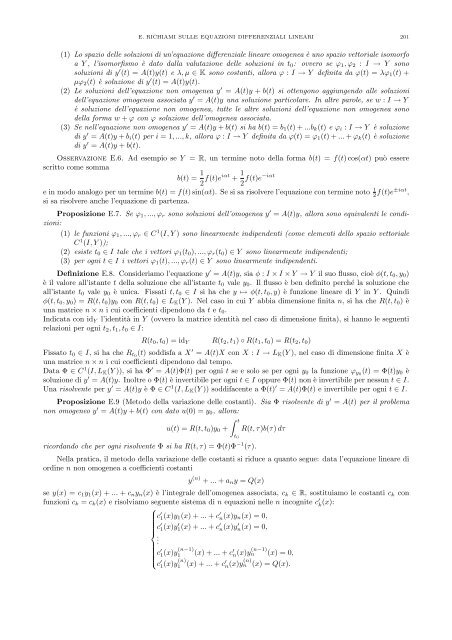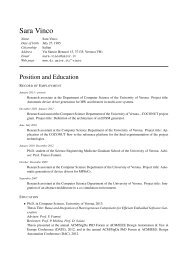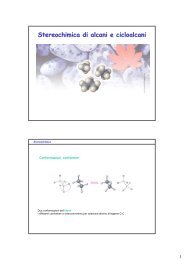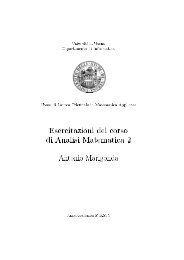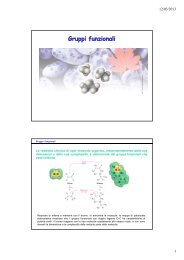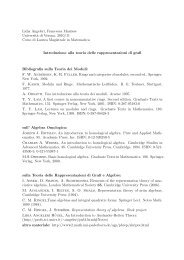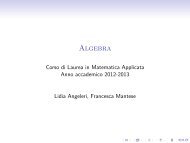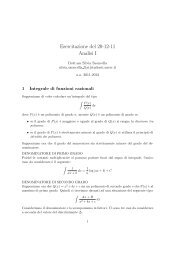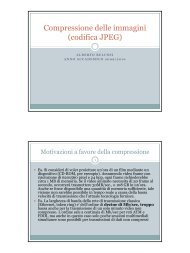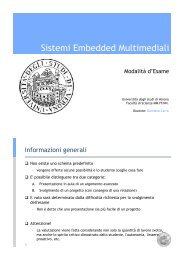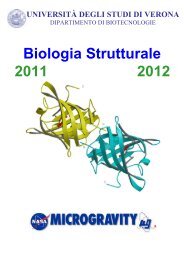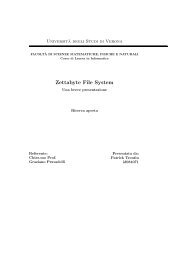You also want an ePaper? Increase the reach of your titles
YUMPU automatically turns print PDFs into web optimized ePapers that Google loves.
E. RICHIAMI SULLE EQUAZIONI DIFFERENZIALI LINEARI 201<br />
(1) Lo spazio delle soluzioni di un’equazione differenziale lineare omogenea è uno spazio vettoriale isomorfo<br />
a Y , l’isomorfismo è dato dalla valutazione delle soluzioni in t0: ovvero se ϕ1, ϕ2 : I → Y sono<br />
soluzioni di y ′ (t) = A(t)y(t) e λ, µ ∈ K sono costanti, allora ϕ : I → Y defin<strong>it</strong>a da ϕ(t) = λϕ1(t) +<br />
µϕ2(t) è soluzione di y ′ (t) = A(t)y(t).<br />
(2) Le soluzioni dell’equazione non omogenea y ′ = A(t)y + b(t) si ottengono aggiungendo alle soluzioni<br />
dell’equazione omogenea associata y ′ = A(t)y una soluzione particolare. In altre parole, se w : I → Y<br />
è soluzione dell’equazione non omogenea, tutte le altre soluzioni dell’equazione non omogenea sono<br />
della forma w + ϕ con ϕ soluzione dell’omogenea associata.<br />
(3) Se nell’equazione non omogenea y ′ = A(t)y + b(t) si ha b(t) = b1(t) + ...bk(t) e ϕi : I → Y è soluzione<br />
di y ′ = A(t)y + bi(t) per i = 1, ..., k, allora ϕ : I → Y defin<strong>it</strong>a da ϕ(t) = ϕ1(t) + ... + ϕk(t) è soluzione<br />
di y ′ = A(t)y + b(t).<br />
Osservazione E.6. Ad esempio se Y = R, un termine noto della forma b(t) = f(t) cos(αt) può essere<br />
scr<strong>it</strong>to come somma<br />
b(t) = 1<br />
2 f(t)eiαt + 1<br />
2 f(t)e−iαt<br />
e in modo analogo per un termine b(t) = f(t) sin(αt). Se si sa risolvere l’equazione con termine noto 1<br />
2f(t)e±iαt ,<br />
si sa risolvere anche l’equazione di partenza.<br />
Proposizione E.7. Se ϕ1, ..., ϕr sono soluzioni dell’omogenea y ′ = A(t)y, allora sono equivalenti le condizioni:<br />
(1) le funzioni ϕ1, ..., ϕr ∈ C 1 (I, Y ) sono linearmente indipendenti (come elementi dello spazio vettoriale<br />
C 1 (I, Y ));<br />
(2) esiste t0 ∈ I tale che i vettori ϕ1(t0), ..., ϕr(t0) ∈ Y sono linearmente indipendenti;<br />
(3) per ogni t ∈ I i vettori ϕ1(t), ..., ϕr(t) ∈ Y sono linearmente indipendenti.<br />
Definizione E.8. Consideriamo l’equazione y ′ = A(t)y, sia φ : I × I × Y → Y il suo flusso, cioè φ(t, t0, y0)<br />
è il valore all’istante t della soluzione che all’istante t0 vale y0. Il flusso è ben defin<strong>it</strong>o perché la soluzione che<br />
all’istante t0 vale y0 è unica. Fissati t, t0 ∈ I si ha che y ↦→ φ(t, t0, y) è funzione lineare di Y in Y . Quindi<br />
φ(t, t0, y0) = R(t, t0)y0 con R(t, t0) ∈ LK(Y ). Nel caso in cui Y abbia dimensione fin<strong>it</strong>a n, si ha che R(t, t0) è<br />
una matrice n × n i cui coefficienti dipendono da t e t0.<br />
Indicata con idY l’ident<strong>it</strong>à in Y (ovvero la matrice ident<strong>it</strong>à nel caso di dimensione fin<strong>it</strong>a), si hanno le seguenti<br />
relazioni per ogni t2, t1, t0 ∈ I:<br />
R(t0, t0) = idY<br />
R(t2, t1) ◦ R(t1, t0) = R(t2, t0)<br />
Fissato t0 ∈ I, si ha che Rt0(t) soddisfa a X ′ = A(t)X con X : I → LK(Y ), nel caso di dimensione fin<strong>it</strong>a X è<br />
una matrice n × n i cui coefficienti dipendono dal tempo.<br />
Data Φ ∈ C 1 (I, LK(Y )), si ha Φ ′ = A(t)Φ(t) per ogni t se e solo se per ogni y0 la funzione ϕy0(t) = Φ(t)y0 è<br />
soluzione di y ′ = A(t)y. Inoltre o Φ(t) è invertibile per ogni t ∈ I oppure Φ(t) non è invertibile per nessun t ∈ I.<br />
Una risolvente per y ′ = A(t)y è Φ ∈ C 1 (I, LK(Y )) soddifacente a Φ(t) ′ = A(t)Φ(t) e invertibile per ogni t ∈ I.<br />
Proposizione E.9 (Metodo della variazione delle costanti). Sia Φ risolvente di y ′ = A(t) per il problema<br />
non omogeneo y ′ = A(t)y + b(t) con dato u(0) = y0, allora:<br />
u(t) = R(t, t0)y0 +<br />
ricordando che per ogni risolvente Φ si ha R(t, τ) = Φ(t)Φ −1 (τ).<br />
t<br />
t0<br />
R(t, τ)b(τ) dτ<br />
Nella pratica, il metodo della variazione delle costanti si riduce a quanto segue: data l’equazione lineare di<br />
ordine n non omogenea a coefficienti costanti<br />
y (n) + ... + any = Q(x)<br />
se y(x) = c1y1(x) + ... + cnyn(x) è l’integrale dell’omogenea associata, ck ∈ R, sost<strong>it</strong>uiamo le costanti ck con<br />
funzioni ck = ck(x) e risolviamo seguente sistema di n equazioni nelle n incogn<strong>it</strong>e c ′ k (x):<br />
⎧<br />
⎪⎨<br />
.<br />
.<br />
⎪⎩<br />
c ′ 1(x)y1(x) + ... + c ′ n(x)yn(x) = 0,<br />
c ′ 1(x)y ′ 1(x) + ... + c ′ n(x)y ′ n(x) = 0,<br />
c ′ 1(x)y (n−1)<br />
1<br />
c ′ 1(x)y (n)<br />
(x) + ... + c ′ n(x)y (n−1)<br />
n (x) = 0,<br />
1 (x) + ... + c ′ n(x)y (n)<br />
n (x) = Q(x).


